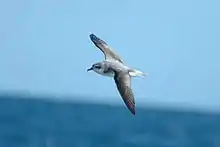Cook's petrel
Cook's petrel (Pterodroma cookii) or the blue-footed petrel,[2] is a Procellariform seabird. It is a member of the gadfly petrels and part of the subgroup known as Cookilaria petrels, which includes the very similar Stejneger's petrel.
| Cook's petrel | |
|---|---|
 | |
| Scientific classification | |
| Kingdom: | Animalia |
| Phylum: | Chordata |
| Class: | Aves |
| Order: | Procellariiformes |
| Family: | Procellariidae |
| Genus: | Pterodroma |
| Species: | P. cookii |
| Binomial name | |
| Pterodroma cookii (G.R. Gray, 1843) | |
Morphology
.jpg.webp)
One of the smallest petrels, Cook's petrel is typically 25–30 cm (9.8–11.8 in) in length with a 65–66 cm (26–26 in) wingspan and a weight of around 200 g (7.1 oz). Its colouration is typical of gadfly petrels: pale grey upperparts with a dark grey "M" on the wings and white underparts.[3]
The bill is long and black with tubular nostrils on both sides. As in all members of the order Procellariiformes, this nostril configuration enables an exceptionally acute sense of smell, which the birds use to locate food and nest sites in the dark.
Diet
Cook's petrel feeds mostly on fish and squid, with some crustaceans taken. The species is highly pelagic except when nesting.
Habitat

Cook's petrel breeds only in New Zealand on three small islands: Little Barrier Island, Great Barrier Island, and Codfish Island. The breeding season is the southern summer, October–May.[3] It nests in burrows and rock crevices, preferring sites on thickly forested ridges. The species was formerly more numerous; the current population estimate is 1,258,000 and declining. It is classified as vulnerable because it breeds on only three small islands. While Little Barrier Island's population remains stable, the other two populations are decreasing. On Great Barrier Island, introduced pigs, dogs, rats and cats attack nests and burrows, as do native weka (a flightless rail), preying on eggs and nestlings and reducing the population from an estimated 20,000 to 100.
Cook's petrel migrates to the Pacific Ocean from New Zealand when it is not breeding. It has sometimes been seen off the west coast of the United States and off the west coast of tropical South America.
References
- BirdLife International (2012). "Pterodroma cookii". IUCN Red List of Threatened Species. 2012. Retrieved 26 November 2013.CS1 maint: ref=harv (link)
- http://nzbirdsonline.org.nz/species/cooks-petrel
- Robertson, Hugh; Barrie, Heather (1999). The Hand Guide to the Birds of New Zealand. Penguin. ISBN 978-0198508311.
- Cook's petrel media from ARKive
- Field Guide to the Birds of North America. National Geographic. ISBN 0-7922-6877-6.
- Harrison, Peter. Seabirds, an Identification Guide. ISBN 0-395-60291-2.
- del Hoyo, Josep (ed.). Handbook of the Birds of the World. Vol 1. ISBN 84-87334-10-5.
- Sibley, David Allen (2000). The Sibley Guide to Birds. New York: Knopf. p. 483. ISBN 0-679-45122-6.
External links
| Wikimedia Commons has media related to Pterodroma cookii. |
| Wikispecies has information related to Pterodroma cookii. |
- BirdLife species factsheet for Pterodroma cookii
- "Pterodroma cookii". Avibase.

- "Cook's petrel media". Internet Bird Collection.
- Cook's petrel photo gallery at VIREO (Drexel University)
- Interactive range map of Pterodroma cookii at IUCN Red List maps
- Audio recordings of Cook's petrel on Xeno-canto.
